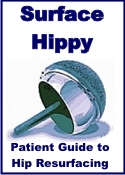|
|
The Case for a Fixed-Bearing Unicompartmental Knee Arthroplasty
READ COMPLETE ARTICLE
Douglas Naudie, M.D., FRCSC
Assistant Professor, University of Western Ontario
London, ON
First introduced in the 1970�s, the unicompartmental knee arthroplasty did not
gain initial widespread acceptance. Early reports by Insall and Aglietti, and
Laskin suggested a high failure rate. However these studies included patients
who underwent concomitant patellectomy, had inflammatory arthropathy, or who had
a very thin (6 mm) tibial polyethylene component1,2. Over the subsequent decade,
however, good results were reported for both medial and lateral unicompartmental
designs, as the indications for unicompartmental arthroplasty gradually became
better defined3,4. Longer follow-up studies have since reported ten-year
survival rates without revision for unicompartmental implants ranging from 82%
to 98%5-14.
In appraising the literature, however, it is important to distinguish between
mobile-bearing and fixed-bearing unicompartmental implants. Mobile-bearing
implants have a fully congruent articulation that moves freely on a polished
tibial baseplate, and the theory of this design has been previously published15.
Fixed-bearing implants have a relatively nonconforming articular surface, which
can be inserted as an all-polyethylene tibial component, or as a non-modular or
modular metal-backed tibial component. Proponents of mobile-bearing
unicompartmental implants believe this design has improved wear characteristics
over fixed-bearing implants, and thus may offer a survival advantage in the
long-term16
The reality is that both designs have demonstrated excellent ten-year
survivorship free of revision. Cartier and associates report a ten-year
survivorship using the Marmor fixed-bearing prosthesis of 93%5. Recently,
O�Rourke and associates report continued excellent survivorship with the same
implant at a minimum of twenty-one year follow-up6. Argenson and associates
report a 94% ten-year survivorship with the Miller-Galante fixed-bearing
implant7. Using the same fixed-bearing implant, we report 90% ten-year
survivorship; and Berger and associates report a 98% ten-year survivorship8,9.
On the mobile-bearing side, Murray and associates report ten-year survival rates
free of revision of 98% using the Oxford prosthesis10. Price and associates also
report an excellent ten-year (95%) survivorship with the Oxford prosthesis11.
Other studies have not reproduced these numbers, however, and have actually
reported lower ten-year survivorship rates than fixed-bearing implants. Keblish
and Briard report 82% prosthetic survivorship at 11 years using the Oxford and
Low Contact Stress (LCS) mobile-bearing implants12. Similarly, Vorlat and
associates report a cumulative survival rate of 82% at ten years with the Oxford
mobile-bearing implant13.
There have also been studies directly comparing the results of mobile-bearing
and fixed-bearing implants. Emerson and associates showed a 99% survival for the
mobile-bearing Oxford implant compared to a 93% survival for the fixed-bearing
Brigham implant at 11 years16. However, an initial comparison of the Oxford
unicompartmental arthroplasty implant to the fixed-bearing Marmor implant
revealed a significantly higher cumulative revision rate with the Oxford
implant17. Another recent study by Gleeson and associates also found that the
Oxford mobile-bearing prosthesis had a higher re-operation rate and
significantly less pain relief than the St. Georg sled fixed-bearing implant18.
The case for a fixed-bearing rather than a mobile-bearing unicompartmental
implant, therefore, can be made on the basis of more reproducible long-term
survivorship. In fact, Swedish registry data does not support the widespread use
of a mobile-bearing unicompartmental implant because of the increased rates of
revision observed in Sweden17,19. Fixed-bearing unicompartmental implants are
probably also less technically demanding than mobile-bearing implants, which
require exact balancing and intact cruciate ligaments15. Dislocation of the
bearing has been described, for example, as a unique complication in association
with the Oxford knee20,21.
A fixed-bearing implant is also more versatile than a mobile-bearing implant. A
fixed-bearing implant can be successfully employed as a lateral compartment
arthroplasty with excellent long-term results recently reported22. When the
Oxford mobile-bearing arthroplasty is used in the lateral compartment of the
knee, ten percent of the bearings dislocate21. A fixed-bearing implant also
permits use of an all-polyethylene tibial component, allowing for a thicker
polyethylene insert without resection of additional host bone. Excellent results
using an all-polyethylene tibial component have recently been reported23.
Finally, a fixed-bearing implant is less expensive than a mobile-bearing
implant, particularly when an all-polyethylene tibial component is employed.
In summary, unicompartmental knee arthroplasty remains an excellent treatment
alternative for osteoarthritis confined to the medial or lateral part of the
knee joint. Fixed-bearing implants have been shown to provide good pain relief
and restoration of function, and have reproducibly demonstrated excellent
survivorship into the second decade. This author makes the case for a
fixed-bearing over a mobile-bearing implant because they are technically easier,
avoid the complication of bearing dislocation, are more versatile, and less
expensive.
References
1. Insall J., Aglietti P. A five to seven-year follow-up of unicondylar
arthroplasty. J Bone Joint Surg Am. 1980;62(8):1329-37.
2. Laskin R.S. Unicompartmental tibiofemoral resurfacing arthroplasty. J Bone
Joint Surg Am. 1978;60(2):182-5.
3. Kozinn S.C., Scott R. Unicondylar knee arthroplasty. J Bone Joint Surg Am.
1989;71(1):145-50.
4. Corpe R.S., Engh G.A. A quantitative assessment of degenerative changes
acceptable in the unoperated compartments of knees undergoing unicompartmental
replacement. Orthopedics. 1990;13(3):319-23.
5. Cartier P., Sanouiller J.L., Grelsamer R.P. Unicompartmental knee
arthroplasty surgery. 10-year minimum follow-up period. J Arthroplasty.
1996;11(7):782-8.
6. O�Rourke M.R., Gardner J.J., Callaghan J.J., et al. The John Insall Award:
unicompartmental knee replacement: a minimum twenty-one year follow-up study.
Clin Orthop Relat Res. 2005;440:27-37.
7. Argenson J.A., Chevrol-Benkeddache Y.C., Aubaniac J. Modern unicompartmental
knee arthroplasty with cement: A three to ten-year follow-up study. J Bone Joint
Surg Am. 2002;84(12):2235-37.
8. Naudie D., Guerin J., Parker D.A., et al. Medial unicompartmental knee
arthroplasty with the Miller-Galante prosthesis. J Bone Joint Surg Am. 2004
Sep;86-A(9):1931-5.
9. Berger R.A., Meheghini R.M., Jacobs J.J., et al. Results of unicompartmental
knee arthroplasty at a minimum of ten years of follow-up. J Bone Joint Surg Am.
2005;87(5):999-1006.
10. Murray D.W., Goodfellow J.W., O'Connor J.J. The Oxford medial
unicompartmental arthroplasty: a ten-year survival study. J Bone Joint Surg Br.
1998;80(6):983-9.
11. Price A.J., Waite J.C., Svard U. Long-term clinical results of the medial
Oxford unicompartmental knee arthroplasty. Clin Orthop. 2005; 435:171-180.
12. Keblish P.A. and Briard J.L. Mobile-bearing unicompartmental knee
arthroplasty: a 2-center study with an 11-year (mean) follow-up. J Arthroplasty.
2004; 19(7-S2):87-94.
13. Vorlat P., Putzets G., Cottenie D., et al. The Oxford unicompartmental knee
prosthesis: an independent 10-year survival analysis. Knee Surg Sports Traumatol
Arthrosc. 2006; 14(1): 40-5.
14. Goodfellow J., O'Connor J. The mechanics of the knee and prosthesis design.
J Bone Joint Surg Br. 1978;60-B(3):358-69.
15. Price A.J., Short A., Kellett C., et al. Ten-year in vivo wear measurement
of a fully congruent mobile bearing unicompartmental knee arthroplasty. J Bone
Joint Surg Br. 2005;87(11):1493-7.
16. Emerson R.H., Hansborough T., Reittman R.D., et al. Comparison of a Mobile
with a Fixed-Bearing Unicompartmental Knee Implant. Clin Orthop Relat Res. 2002;
404:62-70.
17. Lewold S., Goodman S., Knutson K., et al. Oxford meniscal bearing knee
versus the Marmor knee in unicompartmental arthroplasty for arthrosis. A Swedish
multicenter survival study. J Arthroplasty. 1995;10(6):722-31.
18. Gleeson R.E., Evans R., Ackroyd C.E., et al. Fixed or mobile bearing
unicompartmental knee replacement? A comparative cohort study. Knee.
2004;11(5):379-84.
19. Robertsson O., Knutson K., Lewold S., Lidgren L. The routine of surgical
management reduces failure after unicompartmental knee arthroplasty. J Bone
Joint Surg Br. 2001;83(1):45-9.
20. Verhaven E., Handelberg F., Casteleyn, et al. Meniscal bearing dislocation
in the Oxford knee. Acta Orthop Belg. 1991;57(4):430-2.
21. Robinson B.J., Rees J.L., Price A.J., et al. Dislocation of the bearing of
the Oxford lateral unicompartmental arthroplasty. A radiological assessment. J
Bone Joint Surg Br. 2002;84(5):653-7.
22. Pennington D.W., Swienckowski J.J., Lutes W.B., et al. Lateral
unicompartmental knee arthroplasty: survivorship and technical considerations at
an average follow-up of 12.4 years. J Arthroplasty. 2006;21(1)13-7.
23. Hyldahl H.C., Regner L., Carlsson L., et al. Does metal backing improve
fixation of tibial component in unicondylar knee arthroplasty: a randomized
radiostereometric analysis. J Arthroplasty. 2001;16(2):174-179.
READ COMPLETE ARTICLE
|
|




